The right pot for the right plant
• Create a scenery with pots
• Growing plants in unusual containers
• Make your potted plants more beautiful
• Choose the material of pots
• Look after your pots to make them last
• The right pot for the right plant
• Upright-growing plants in pot
• Growing a tree in a pot
• Hiding a cumbersome stump
• Hiding the compost heap
• Optimize Trees
• How to redesign a flowerbed ?
• Create a flowering border like a painter
• Harmonise foliage between them
• Succeed with your borders
• An attractive garden in winter
• Create a Mediterranean corner
• Create an exotic area
• Create a Japanese corner
• Create a green roof
• Create a rockery
• An Acer, for all gardens
As when you arrange a bouquet, a plant has a different effect depending on the pot in which it is grown. Well match the content with the container is an art which is not so complicated and which will boost your creativity!
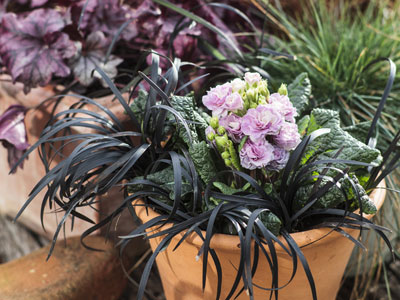
A beautiful pot plant is a successful match between the plant and its container.
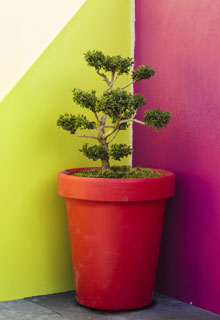
The plant is too small… or the pot is too big!
The plant is too small… or the pot is too big!
The volume of the plant and of the pot must be in relation. A small plant in a huge pot won't do. The pot and the plant must have approximately the same height. If the plant is very tall (a plant grown as a standard, for example) the pot must be at least half the height of the plant's height. This will enhance the plant's shape.
But it is not solely the height which is important: the width of the pot is also a factor. The largest the pot, the least height is needed to give balance to a tall plant. A long window box (1 m for example) is perfect to house a line of ornamental grasses or Bamboos.
Second rule: the shape
The easiest plants to match with a pot are the ones called ‘architectural'. Their shape is highly clear and sleek, like the horsetails (vertical), the Yuccas (in large rosettes), the Phormiums (weeping ribbons) and many others. These plants are the favourite's ones in contemporary gardens. They need pots which have a regular shape and which are rather plain.
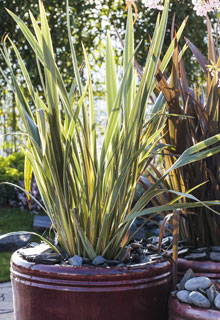
Architectural plants (here, a variegated Phormium –New Zealand Flax) need a sleek-shaped pot.
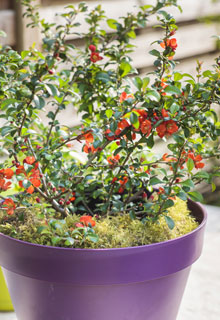
A pot which has a regular shape enhances the messy look of a shrub (here, a Japanese quince tree).
The plants which have not an architectural shape are useful to create atmosphere. Their pot needs to be in relation to this atmosphere. A small flowering Rose in a plain, cylindrical pot does not give the right effect. In a weaved-resin pot, it will look much better and the countryside look of one will perfectly match the other. So you need to choose the atmosphere you wish to create!
A few tips
| Shape of the container | Suitable Plants | Examples |
|---|---|---|
| Low, round | Low plants, plants in rosettes | Heucheras, Ophiopogon, Flowering bulbs… |
| Tall, High | Plants grown as standard or Half standard | Standard- Bay-Laurel, fruit trees… |
| Ball-shaped | Clump-forming plants | Ornamental grasses, Agapanthus… |
| Square or rectangular | Standard-grown plants or topiaries | Climbing plants, Citrus trees, Standard Olive tree… |
| Curved | Weeping plants | Gypsophila, Carex, Ivy… |
| Regular | Bush-shaped plants | Bamboos, Conifers, Roses, Rhododendrons… |
| Wide-mouthed | Tall plants | Banana trees, Cycas (Japanese Sago Palm), palm trees… |
Third rule: the colours
Looking for a pot which has tones which match or get close to the plant's tones (or unlike it) is not necessarily a good idea: colours which are too similar do not enhance each element. Bi-colours pots, on the other hand allow you to play with colour while letting the plant be visible. They are very useful in winter to brighten up the base of deciduous plants, such as Japanese Maples or Gingko. In a word, give free rein to your imagination!
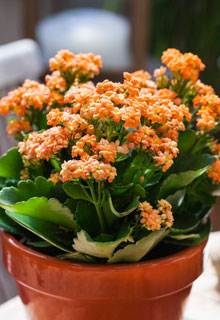
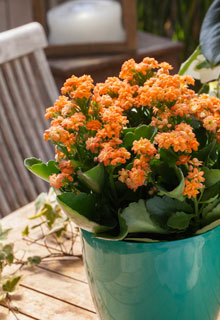
The same plant, in a pot matching its flowers' colours and in a pot which has a totally different colour:
it is definitely in the latest that the plant is better shown off!















































































































































































































































